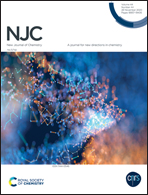Synthesis of fluorescent and water-soluble silicon nanoparticles with a high pH response and its application to pH measurement and gastric parietal cell imaging†
Abstract
An extensive comprehension of biochemical activities occurring in living systems is crucial for prior detection of diseases and characterization of suitable treatments. To understand the pathological/physiological conditions in living cells, pH monitoring is an important tool. To date, the facile synthesis of nanosensors with strong fluorescence coupled with long emission wavelength and good photostability for pH monitoring is still scanty. In this work, new fluorescent silicon nanoparticles (Si NPs) allowing pH sensing were designed. The Si NPs were obtained from the mixture of 3-[2-(2-aminoethylamino)ethylamino]propyl-trimethoxysilane (AEEA) and 2-aminophenol in one-pot, and under 480 nm excitation, they emitted yellow fluorescence at 560 nm. The Si NPs exhibited excellent salt and temperature tolerance, robust photo stability, and high contrast fluorescence. Furthermore, the prepared Si NPs had been successfully applied to pH measurement in fruit juice samples and fluorescence imaging of gastric parietal cells in tissue sections, providing a new approach for eosinophilic cell staining.



 Please wait while we load your content...
Please wait while we load your content...